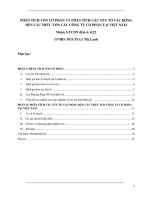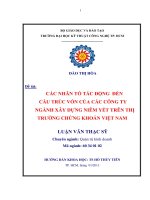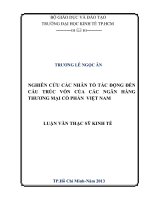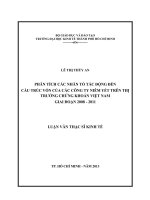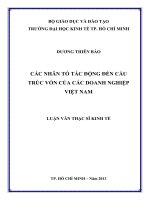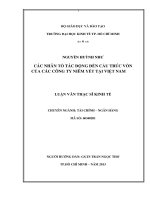Phân tích các nhân tố tác động đến cấu trúc vốn của doanh nghiệp sản xuất công nghiệp viết namtieesng anh
Bạn đang xem bản rút gọn của tài liệu. Xem và tải ngay bản đầy đủ của tài liệu tại đây (173.82 KB, 27 trang )
MINISTRY OF EDUCATION AND TRAINING
FOREIGN TRADE UNIVERISTY
PHD THESIS SUMMARY
ANALYSIS OF THE DETERMINANTS OF
CAPITAL STRUCTURE OF VIETNAMESE INDUSTRIAL FIRMS
Major
Specialized
Code number
:
:
:
Business
Business administration
62.34.01.02
PHAN THANH HIEP
HANOI, 2017
THIS THESIS IS COMPLETED IN
FOREIGN TRADE UNIVERSITY
SUPPERVISOR: ASSOC. PROF, DR NGUYEN DINH THO
Reviewer 1: ASSOC. PROF, DR DINH TRONG THINH
Reviewer 2: ASSOC. PROF, DR NGUYEN HUU ANH
Reviewer 3: ASSOC. PROF, DR LE THI KIM NHUNG
The thesis will be defended at
Assessment Thesis Council of Foreign Trade University
At date
month
Can refer to the thesis:
- Vietnam National Library
- Library of Foreign Trade University
year
1
INTRODUCTION
1. Rationales
The main content of this thesis is researching the factors impact on the
capital structure of Vietnamese industrial firms. The capital structure issue has not
been defined clearly but following most academic papers in this field, within this
thesis, the term of capital structure will be understood as the correlation between
debt and equity in total assest of firm.
In corporate administration, managing capital structure plays an extremly
important role. Some theories showed that it affects to the value of firm. Besides
that, it also affects the profitability of firm. So the issue of managing capital
structure is very important and need to be anaylized deeply.
However, the capital structure is not running independently by the intent of
the managers. It would seem that there are some factors impact on capital structure
of firm. So, analyzing how these factors impact on the change of capital structure is
a very significant research and it would help the directors to manage the capital
structure.
It also would seem that capital structure of firm varies from different
industries. For example, capital structure of commerce firms is different from it of
heavy industrial firms. So, it is necessary to focus on a specific industry to analyses.
Base on this view, this thesis has chosen industrial firms which plays important role
in the modernization and industrialization process of Vietnam to research.
Finally, the concept of capital structure and the impact of some determinants
to the capital structure of Vietnamese firms have been studied for years. In theorem
research, these papers refer to almost of capital structure theories such as: trade off
theory, perking order theory, agency-cost theory, signaling model theory, market
timing theory… In empirical research, there have been multiple samples to be
collected and analyzed, but the results seem to be different from each paper.
Especially, most of capital structure papers for Vietnamese firms focus mainly on
the impact of determinants to the capital structure and dropt the impact of the
capital structure to the value of firm. This is a very important issue because it may
lead to the endogenous problem among variables in the model. Most of the papers
2
in this field in Vietnam use Fixed effect model (FEM) and Random effect model
(REM) to run the regression. In the theory, these two models are unable to
overcome the endogenous problem. So, using the model of Generalized Method of
Moments (GMM) which can solve the endogenous issue could be viewed as a new
solution of this thesis in the way to approach the research of determinants of capital
structure.
2. Literature review
This content will be show in the chapter 1 of the thesis.
3. Objectives of the research
The main objective of this paper are defining and analyzing the impact of
some determinants on the capital structure of industrial firms in Vietnam.
4. Object and scope of the research
4.1. Objects
Objects of this research contain three issues:
-
Theories of capital structure.
-
Theories of impacts of some determinants on capital structure.
-
Empirical studies about the impacts of some determinants on capital
structure.
-
Industrial firms in Vietnam.
4.2. Scope of the research
Scope of the research is limit in some issues:
-
In the content of capital structure theories: this thesis mentions some key
fundamental theories about capital structure and impacts or some
determinants on capital structure.
-
In the content of impacts of some determinants on capital structure, this
thesis approaches the problem by clarifying the determinants into two
categories: (1) business factors and (2) corporate governance factors.
-
Firms in research sample: audited financial report of 95 Vietnamese listed
industrial firms in period of 2006 – 2015.
5. Methodology
3
Following most of economic researches, this thesis uses simultaneously two
study methods: qualitative method and quantitative method to complete the
objectives of the thesis.
6. New contribution of the thesis
In the perspective of science, this thesis contributes some points as: (1) this
thesis runs empirical studies for impacts of determinants on capital structure (2) this
thesis uses two models for studying the impacts of some determinants on capital
structure, the first one uses business factor variables and the other uses corporate
governance factor variables, (3) This thesis use GMM model which could be
viewed as a new economic methodology in Vietnam, (4) Mentioning the optimum
capital structure for Vietnamese industrial companies by running the threshold
regression model, (5) This thesis focuses on Vietnamese industrial companies,
which could be the leading team in the economic growth of Vietnam.
In the perspective of practical application, this thesis makes some new
points as: (1) providing the actual view of capital structure of Vietnamese industrial
firms to the managers, (2) showing the ways how the capital structure affects the
firm’s value, then suggesting some solutions for the managers to improve the firm’s
value, (3) showing the determinants of capital structure then giving some advices
for the directors to manage capital structure.
7. Dissertation Structure
Apart from the Forewords, Conclusion, Appendix, Reference and lists, this
dissertation contains 6 chapters.
Chapter 1: Literature review
Chapter 2: Theories of capital structure and impact of determinants on capital
structure.
Chapter 3: The actual status of capital structure of Vietnamese industrial firm
Chapter 4: Data description, research models and methodology
Chapter 5: Analyzing the regression result of impact of determinants on
capital structure model
Chapter 6: Solutions and recommendations to improve capital structure policy
of Vietnamese industrial firms.
4
Chapter 1: Literature reviews of determinants of capital structure
1.1 Literature reviews of business factors impact on capital structure
1.1.1 Some important international studies
1.1.1.1 In the period of before 2000
Survey of Harris and Raviv (1991), which summarizes the empirical results
in the studies of: Bradley (1984), Long and Malitz (1985), Kester (1986), Marsh
(1982) and Titman and Wessels (1988) shows the specific finding as below:
Table 1.1: Summary of how business factor impact on capital structure in
some empirical studies before 2000
Bradley
Determinants
et al.
Volatility
Long
and
Titman
Kester
Marsh
Malitz
Wessels
-*
-
and
Bankruptcy threat
-
-*
-
Tangibility
+
+
+*
-
-*
-
-*
Development oppoturnity
+
-*
Firm’s size
-*
Non debt tax shield
+
Advertising expenditure
-
-
Research and development fee
-
-
Profitability
+*
The uniqueness of firm
Source: Survey of Harris and Raviv (1991).
+
-*
-
5
In the above table, the plus mark represents the positive relationship, minus
marks show the negative relationship, blank gap show the paper do not sdudy these
factors, * mark may show the correlation level but without any statistic meanings.
1.1.1.2 Some important studies after 2000.
Some important studies in this period are: Huang and Song (2006), Chen
(2003), Pandey (2002) and some other studies.
1.1.2 Some important studies in Vietnam
1.1.2.1 The research of Tran Dinh Khoi Nguyen and Rammachandran (2006) for
small and medium business
1.1.2.2 The research of Doan Ngoc Phi Anh (2010) with path analysis model
1.1.2.3 The research of Okuda and Lai Thi Phuong Nhung (2010) and the static
trade-off theory
1.1.2.4 The research of Le Dat Chi (2003) and the perking order theory
1.1.2.5 The research of Le Thi Phuong Vi and Phan Thi Bich Nguyet for the stateowned factor impact on the capital structure of firm
1.1.2.6 The research of Dang Thi Quynh Anh and Quach Thi Hai Yen (2014) for the
determinants of the capital structure of firms listed in HOSE
1.1.2.7 The research of Tran Hung Son (2012) for the study sample with
Vietnamese industrial firms
1.1.3 Summary of how business factors impact on capital structure in some
empirical studies
Table 1.2: Summary of determinants of capital structure in some empirical studies
Factor
Trends
Some important studies
Titman and Wessels (1988), Antonio, Guney and
Paudyal (2002), Hall, Hutchison, Michaels (2004),
Firm size
Positive
Deesomsak (2004), Huang and Song (2006), Pandey
(2002), Frank and Goyal (2007), Doan Ngoc Phi Anh
(2010), Okuda and Lai Thi Phuong Nhung (2010), Dang
Thi Quynh Anh and Quach Thi Hai Yen (2014)
Profitability
Positive
Erol (2004), Pandey (2002), Dang Thi Quynh Anh and
Quach Thi Hai Yen (2014).
6
Meyrs and Majluf (1984), Kester (1986), Thies and Klock
(1992), Titman and Wessels (1988), Chen (2003), Hall,
Negative
Hutchison, Michaels (2004), Deesomsak (2004), Tran
Dinh Khoi Nguyen (2006), Pandey (2002), Doan Ngoc
Phi Anh (2010), Okuda and Lai Thi Phuong Nhung
(2010).
Growth
Positive /
Myers (1977), Chen and Zhao (2006), Pandey (2002),
Opportunity
Negative
Frank and Goyal (2007)
Positive
Bhaduri (2002)
Negative
Titman and Wessels (1988), Pandley (2002)
Growth Speed
Positive
Tangibility
Negative
Chen (1998), Pandley (2002), Chen (2003), Huang and
Song (2006), Tran Hung Son (2012)
Huang and Song (2006) Tran Dinh Khoi Nguyen and
Ramachandran (2006), Doan Ngoc Phi Anh (2010)
Pandly (2002), Huang and Song (2001), Bradley et al.
Negative
(2006), Pandey (2002), Doan Ngoc Phi Anh (2010)
Volatility
Liquidity
Relationship
with bank
Corporate
income tax
(1984), Titman and Witsell (1988), Huang and Song
Positive
Tran Dinh Khoi Nguyen and Ramachandran (2006)
Negative
Deesomsak (2004)
Petersen and Rajan (1994), Donnelly, Berry, and
Positive
Thompson (1985), Tran Dinh Khoi Nguyen and
Ramachandran (2006)
Positive
Negative
M & M (1963)
Tran Hung Son (2012), Dang Thi Quynh Anh and
Quach Thi Hai Yen (2014).
1.2 Literature reviews of business factors impact on capital structure
1.3 Literature reviews of corporate governance factors impact on capital
structure
7
There are some important studies in this topic such as: Ahmad et al. (2015),
Agyei et al. (2014), Jaradat (2015), Tran Dinh Khoi Nguyen and Ramachandran (2006),
Le Thi Phuong Vy and Phan Bich Nguyet (2015).
Table 1.3: Summary of how corporate governance factors impact on capital
structure in some empirical studies
Factors
Impacts on
capital structure
Positive
The board size
CEO duality
Ahmad and et al.(2015), Agyei and et al.
(2014), Jaradat (2015)
Negative
Ranti (2013)
Positive
Ranti (2013)
Negative
Agyei and et al. (2014)
Without statistic
meaning
Board structure
Some important studies
Positive
Jaradat (2015)
Agyei and et al.(2014)
Agyei and et al.(2014), Tran Dinh Khoi
Organizational ownership
structure
Positive
Nguyen and Ramachandran (2006), Le Thi
Phuong Vy and Phan Bich Nguyet (2015),
Doan Ngoc Phi Anh (2010)
Gender structure of board
Non executive member in
board
Positive
Jaradat (2015) and Agyei and et al.(2014)
Positive
Agyei and et al.(2014), Jaradat (2015)
2. Defining research objectives
After analyzing the literature review, this thesis defines some issues need to
be studied more such as:
8
Firstly, for the concept of affects by some factors to the capital structure of
Vietnamese industrial firms, the thesis needs to approach by two categories of factors:
(1) business factors and (2) corporate governance factors.
Secondly, the literature review shows that the relationship between capital
structure and ROA/ROE/TobinQ indicators is endogenous. So, the GMM model need
to be used to replace FEM and REM model.
Last, the overview shows that the endogenous relationships between capital
structure and profitability could be exist, so to solve this issue, using GMM model
could be more suitable rather than using FEM and REM models.
CHAPTER
2: THEORIES OF CAPITAL STRUCTURE,
IMPACT OF CAPITAL STRUCTURE ON FIRM VALUE AND
IMPACT OF DETERMINANTS ON CAPITAL STRUCTURE
2.1 The definition and measurements of Capital structure
In the study of Bui Van Van et al. (2015), the definition of capital structure is
defined: capital structure is the concept shows the correlation of parts in total capital
of firm. The total capital of firm is divided into two parts: debt and equity. The term
of debt are also divided into two parts basing on the borrowing time: short term debt
and long term debt. In this thesis, some terms of capital structure are referred as:
total debt ratio, long term debt ratio, short term debt ratio, long term capital ratio
and equity ratio.
The measurement of above terms is:
Total debt ratio = Total debt / total asset
Equity ratio = Total equity / Total asset
Short term debt ratio = Short term debt / Total asset
Long term debt ratio = Long term debt / Total asset
Long term capital ratio = (Equity + long term debt)/ Total asset
9
2.2 The fundamental theories of capital structure
2.2.1 Modigliani and Miller theory
2.2.1.1 Modigliani and Miller (1958)
2.2.1.2 Modigliani and Miller (1963)
2.2.2 The static trade of theory and optimum capital structure
2.2.3 Jensen and Meckling theory about agency cost
2.2.4 The perking order theory of Myers and Majluf
2.2.5 The market timing theory
2.2.6 The theories of signaling, risk avoided philosophy, and others
2.3 Literature review of determinants of capital structure
2.3.1 Impact of business factors on capital structure
2.3.1.1 Impact of size factor on capital structure
2.3.1.2 Impact of profitablitily factor on capital structure
2.3.1.3 Impact of growth opporturnity factor on capital structure
2.3.1.4 Impact of growth speed factor on capital structure
2.3.1.5 Impact of tangibility factor on capital structure
2.3.1.6 Impact of volatility factor on capital structure
2.3.1.7 Impact of liquidity factor on capital structure
2.3.1.8 Impact of tax factor on capital structure
2.3.1.9 Impact of interest factor on capital structure
2.3.1.10 Impact of crisis factor on capital structure
2.3.2 Impact of corporate governance factors on capital structure
2.3.2.1 Impact of board size factor on capital structure
2.3.2.2 Impact of CEO Duality factor on capital structure
2.3.2.3 Impact of institutional ownership factor on capital structure
10
2.4 The fundamental issues on managing capital structure
2.4.1 The rules for managing capital structure
2.4.1.1 Rule for controlling the compatibleness
This rule is understood that the long term capital should be used to fund the
long term asset like the fixed asset, and the short term capital should be used for
funding the short term asset like materials, stocks…
2.4.1.2 Rule for balancing the benefit and risk
2.4.1.3 Rule for maintain the right to control company
2.4.1.4 Rule of flexibility
2.4.1.5 Rule of minimization cost of capital
2.4.2 The key issues for using rules in managing capital structure of industrial
firms
2.4.2.1 The context of national economy and capital market
2.4.2.2 The context of industry sector
2.4.2.3 Characteristics of industrial firms
CHAPTER 3: THE ACTUAL FACTS OF CAPITAL STRUCTURE
OF VIETNAMESE INDUSTRIAL FIRMS
3.1 Review of Vietnamese industry sector
The growth speed of industry sector of Vietnam has been maintained around
7% per year since 2005. However, this sector has been accounted for around 38% of
GDP for years.
3.2 The actual facts of capital structure of Vietnamese industrial firms in
comparison with non financial listed firms in Vietnam
3.2.1 Most of Vietnamese industrial firms follow the rule of compatibleness
11
3.2.2 The total debt ratio of Vietnamese industrial firms is lower than the
ratio of non financial listed firms
3.2.3 The long term debt ratio of Vietnamese industrial firms is lower than
the ratio of non financial listed firms and getting lower
3.2.4 There are differences in the movement of short term debt ratio of
Vietnamese industrial firms and non financial listed firms in Vietnam
3.2.5 There are differences in the movement of short term debt ratio of and
long term debt ration of Vietnamese industrial firms
3.2.6 Vietnamese industrial firms are borrowing short term debt more than
long term debt
3.2.7 The relationship among capital structure and economy crisis and
interest rate
The economy crisis in the period 2008 – 2011 with two shock of interest rate
in 2008 and 2011 could not show any significant impact on capital structure of
Vietnamese industrial firms but may impact on ROA.
3.2.8 There are differences between capital structure of state owned
companies and private companies
3.2.9 The relationship between ROA and capital structure of Vietnamese
industrial firms
The statistic analysis may show the possibility that the relationship between
ROA and total debt ratio could be negative.
3.2.10 The relationship between capital structure and the growth speed of
firms
3.2.11 The relationship between the liquidity and capital structure
3.3 The summary of actual facts of capital structure of Vietnamese industrial
firms
The advantage point in capital structure status of Vietnamese industrial firms
is the compatibleness, but it also show some disadvantages such as: (1) the issue of
12
using long term debt to finance short term asset is not necessary, (2) the surplus of
long term capital is not optimal status for firms (3) The trend of reducing long term
debt and maintaining the surplus of long term capital structure simultaneously could
limit the opportunity for firms to expand scale of business.
CHAPTER 4: THE RESEARCH DATA DESCRIPTION,
RESEARCH MODEL AND METHODOLOGY
4.1 The research data description
This thesis build up a panel data from financial report of 95 Vietnamese
industrial firm from 2006 – 2015 for research sample.
4.2 The empirical research framework
4.3 The models for testing the determinants of capital structure
4.3.1 The model of business determinants of capital structure
4.3.1.1 Regression model, variables measurement and assumptions
The regression equation is:
CAP.STRUC i t = αi + β1 SIZE + β2 ROA + β3 TOBIN.Q + β4 GROWTH + β5
TANG + β6 VOLATILITY + β7 LIQUIDITY + β8 TAX + β9 INTEREST + β10
YEAR.DUM + εi t
4.3.1.2 Regression methods and tests
The regression method of this model is SGMM. There are three endogenous
variables: the lag of capital structure, profitability, TobinQ and volatility. The
remaining variables are instrument variables. For the tests, SGMM model uses two
basic tests: Arellano-Bond (AR2) and Hansen test.
4.3.2 The model of corporate governance determinants of capital structure
4.3.2.1 Regression model, variables measurement and assumptions
The regression equation is:
13
CAP.STRUC i t = αi + β1 B.SIZE + β2 CEO.DUAL + β3 CEO.GEN + β4
CEO.AGE + β5 SIZE + β6 STATE + β7 GROW + εi t
4.3.2.2 Regression methods and tests
The regression methods of this model are Fixed Effect Model and Random
Effect Model.
For the tests, there are three tests will be checked: autocorrelation test,
heteroskedasticity test, and Hausman test (if necessary).
4.4 The model for testing the impacts of capital structure on the business
effectiveness and firm value.
CHAPTER 5: ANALYZING THE REGRESSION RESULT OF
DETERMINANTS OF CAPTITAL STRUCTURE MODEL
5.1 The model of business determinants of capital structure
5.1.1 Descriptive statistics and correlation matrix of variables
Table 5.1: Descriptive statistics of capital structure variables
Variables
Number of
observation
Mean
Standard
deviation
Min
Max
BTDTA
855
0,438702
0,213648
0,030923
1,173151
BLDTA
855
0,08983
0,139485
0
0,719237
BSDTA
855
0,348872
0,178588
0,006971
0,80502
MTDTA
855
0,445037
0,248727
0,01127
0,950953
MLDTA
855
0,091262
0,144424
0
0,736801
MSDTA
855
0,354571
0,209072
0,007768
0,909376
Source: Calculated by Stata program
14
Table 5.2: Descriptive statistics of independents variables
Variables
Number of
observation
Mean
Standard
deviation
Min
Max
tobinq
855
1,184366
0,886036
0,298066
14,92568
roa
855
0,081122
0,087285
-0,64551
0,783739
size
855
26,93751
1,467045
22,40122
31,32545
grow
855
0,154552
0,319884
-0,68624
3,311883
TANG
855
0,250017
0,193343
0,12134
0,97642
volatility
855
2,734085
3,270647
0,12453
44,57315
tax
855
0,149423
0,256785
-4,57276
3,819248
liquidity
855
2,450976
2,36708
0,113778
23,23605
interest
855
0,038155
0,036473
0
0,370879
dumyear
855
0,222222
0,415983
0
1
Source: Calculated by Stata program
15
Table 5.3: Correlation matrix of variables
size
grow
tang
volatility
tax
liquidity
interest
tobinq
size
1
grow
0,1735
1
tang
-0,0589
-0,0022
1
volatility
0,0749
0,0942
-0,0934
1
tax
0,043
-0,0331
-0,1412
-0,0108
1
liquidity
-0,1664
-0,0556
-0,1237
0,0247
0,0024
1
interest
-0,0454
-0,027
0,255
-0,0424
-0,1035
-0,136
1
tobinq
0,1286
0,0892
-0,0386
0,264
-0,009
0,0765
-0,1161
1
roa
0,0753
0,1613
-0,1426
0,2131
0,049
0,2499
-0,2638
0,3001
Source: Calculated by Stata program
5.1.2 Regression results and tests
The regression results are collected and showed in the table below. The result
of AR2 and Hansen test show that the regression results are confident because there
is not any auto correlation in second order differences and the instrument variables
in the model are compatible.
roa
1
16
Table 5.4: The regression results of the model of business determinants of capital structure by SGMM method
Factors
Book value of
the total debt
ratio
Book value of
the short term
debt ratio
Book value of
the long term
debt ratio
Market value of
the total debt
ratio
Market value of
the short term
debt ratio
Market value of
the long term
debt ratio
roa
-0,3999***
-0,2740***
-0,0825***
-0,5389***
-0,4133***
-0,1534***
tobinq
0,0021825
-0,0010
0,0079
-1,3227***
-0,099***
-0,0117*
size
0,0076597**
0,0066*
0,0011
0,0229***
0,12**
0,00457*
grow
0,037***
-
-
-
0,024*
-
tang
-0,015
-0,0609**
-0,028
0,0311
-0,127***
0,031818
volatility
0,0001147
-0,0014
0,0009357
-0,01
-0,1363*
0,0037
tax
-
-
-
-
-
-
liquidity
-0,0175***
-0,0195***
0,00165
-0,024***
-0,0234***
0,0016
-0,4233***
-0,1633***
-0,316*
-
- 0,266***
0,0435***
interest
-0,6849
***
YEAR.DUM
0,0093
-0,0037
- 0,015***
0,102***
0,060***
AR2 Test
z = 1,13
Pr > z = 0,258
z = 1,28
Pr > z = 0,200
z = 0,57
Pr > z = 0,569
z = 0,85
Pr > z = 0,394
z = 0,66
Pr > z = 0,510
chi2(55) =
chi2(55) =
chi2(55) =
chi2(69) =
chi2(69) =
chi2(55) =
67,93
Prob > chi2 =
0,113
66,05
Prob > chi2 =
0,146
61,53
Prob > chi2 =
0,254
80,91
Prob > chi2 =
0,155
82,53
Prob > chi2 =
0,127
71,12
Prob > chi2 =
0,071
Hansen Test
z = 0,81
Pr > z = 0,418
17
5.1.3 Regression results analysis
5.2 The model of corporate governance determinants of capital structure
5.2.1 Descriptive statistics and correlation matrix of variables
Table 5.5: Descriptive statistics
Variables
Number of
observation
Mean
Standard
deviation
Min
Max
size
828
27,00158
1,431704
23,27481
31,32545
grow
828
0,1589255
0,320169
-0,68624
3,311883
state
828
0,2608696
0,439374
0
1
b_size
828
1,313281
0,432808
0,693147
2,70805
ceo_dual
828
0,339372
0,473782
0
1
ceo_gen
828
0,9130435
0,286198
0
1
ceo_age
828
50,45169
6,983576
25
72
Source: Calculated by Stata program
18
Table 5.6: VIF Statistic
Variables
VIF
1/VIF
size
1,51
0,66026
b_size
1,44
0,692519
state
1,16
0,861421
ceo_dual
1,12
0,896453
ceo_age
1,11
0,900923
ceo_gen
1,08
0,926713
grow
1,04
0,965943
Mean VIF
1,21
.Source: Calculated by Stata program
5.2.2 Regression results and tests
Table 5.7: Woolridge Test result of autocorrelation on each models
Variables
BTDTA
Woolridge Test
F( 1, 91) =
Pr > F
Conclusion
60,290
0,000
autocorrelation
BSDTA
F( 1,
91) =
36,159
0,000
autocorrelation
BLDTA
F( 1,
91) =
127,326
0,000
autocorrelation
MTDTA
F( 1,
91) =
73,205
0,000
autocorrelation
MSDTA
F( 1,
91) =
58,188
0,000
autocorrelation
MLDTA
F( 1,
91) =
48,751
0,000
autocorrelation
Source: Calculated by Stata program
19
Table 5.8: Test results off heterokedasticcity on each models
Variables
Regression
method
FEM
Test
WALD
Chi2
Pr >
Statistic
Chi2
5583,64
0,000 Heterokedasticity
1835,90
0,000 Heterokedasticity
5988,57
0,000 Heterokedasticity
1733,99
0,000 Heterokedasticity
Conclusion
BREUSCH AND
BTDTA
REM
PAGAN
LAGRANGIAN
FEM
WALD
BREUSCH AND
BSDTA
REM
PAGAN
LAGRANGIAN
FEM
WALD
2.700.000 0,000 Heterokedasticity
BREUSCH AND
BLDTA
REM
PAGAN
1800,57
0,000 Heterokedasticity
13399,06
0,000 Heterokedasticity
1230,00
0,000 Heterokedasticity
16837,69
0,000 Heterokedasticity
1115,57
0,000 Heterokedasticity
LAGRANGIAN
FEM
WALD
BREUSCH AND
MTDTA
REM
PAGAN
LAGRANGIAN
FEM
WALD
BREUSCH AND
MSDTA
REM
PAGAN
LAGRANGIAN
FEM
WALD
3.000.000 0,000 Heterokedasticity
BREUSCH AND
MLDTA
REM
PAGAN
1658,53
LAGRANGIAN
Source: Calculated by Stata program
0,000 Heterokedasticity
20
Table 5.9: The regression results of the model of corporate governance
determinants of capital structure by FGLS method
Independent
variables
BTDTA
BSDTA
BLDTA
MTDTA
MSDTA
0,0275*** 0,037393***
0,0022
grow
0,0144**
0,0003
state
0,0373**
b_size
-0,0004
-0,01244
-0,0031
-0,0189
-0,07056***
-0,00241
ceo_dual
-0,0073
0,010773
-0,0015
-0,01252
-0,00379
-0,00080
size
ceo_gen
0,002866
-0,05082*** 0,0454***
0,0697*** 0,061844***
0,0017
0,038041*** 0,047313***
MLDTA
-0,00598
0,04707**
0,0091*
0,00387**
-0,00132
-0,09334*** 0,04366***
0,108425*** 0,091429***
0,00174
ceo_age
0,0001
0,000617
0,0000
0,000425
-0,00014
0,00003
cons
-0,3856
-0,72765
-0,0143
-0,66727
-0,89972
-0,06516
Source: Calculated by Stata program
5.2.3 Regression results analysis
5.3 Regression models Analysis
21
CHAPTER 6: SOLUTIONS AND RECOMMENDATIONS TO
IMPROVE CAPITAL STRUCTURE POLICY OF VIETNAMESE
INDUSTRIAL FIRMS
6.1 The context of the process for making decision on managing capital
structure of Vietnamese industrial firms
6.1.1 Macro economics context
6.1.1.1 GDP and GDP growth
6.1.1.2 Inflation and interest rate
6.1.2 The growth of stock market and bond market
6.1.3 The context of the lending operation in the bank system in 2007 - 2015
6.1.4 The context of the policies and law by the government
6.1.4.1 The supporting policy for the small and medium business
6.1.4.2 The priority policy for the supporting industrial business
6.1.4.3 The priority policy for the state owned company
6.2 Some solutions to improve the efficiency of managing capital structure of
Vietnamese industrial company
6.2.1 The solutions base on the empirical tests about the impact of
determinants on capital structure
6.2.1.1 Solution base on the impact of size factor on capital structure
6.2.1.2 Solution base on the impact of profitability factor on capital structure
6.2.1.3 Solution base on the impact of growth opportunity factor on capital
structure
6.2.1.4 Solution base on the impact of growth speed factor on capital structure
6.2.1.5 Solution base on the impact of liquidity factor on capital structure
6.2.1.6 Solution base on the impact of interest factor on capital structure
6.2.1.7 Solution base on the impact of tangibility factor on capital structure
22
6.2.1.8 Solution base on the impact of state ownership factor on capital structure
6.2.2 The solutions base on the applications of capital structure theories
6.2.2.1 The perking order theory
6.2.2.2 The trade off theory
6.2.2.3 The market timing theory
6.2.3 Some solutions for specific group of Vietnamese industrial firms
6.2.3.1 For the firms violated the rules of compatibleness in managing capital
structure
These firms need to find out some solutions to overcome the gap between the
value of the long term asset and the value of total long term capital (equity + long
term debt) by increasing the value of equity or long term debt.
6.2.3.2 Review the issue of reducing the long term debt ratio and the solution of
diversifying the capital suppliers
6.2.3.3 For the industrial firms with the total debt ratio exceed the rate of 65%
When the total debt ratio of firm exceeds the rate of 65%, the decision of
borrowing more is very likely lead to the reduction on ROA and ROE indicators. In
opposition, the decision of reducing the debt, could lead to the positive effects in the
firm’s value.
6.2.3.4 For the industrial firms with the total debt ratio is under the rate of 65%
The solution for firms in this case is keep borrowing more to increase ROE
indicator but the manager should always concern the impact of reducing ROA when
applying this solution. It is better if this solution comes together with the solution to
improve the ROA indicator of firms.
6.2.3.5 For the listed Vietnamese industrial firms and taking the advantage from
the development of stock market and the bond market
The listed Vietnamese industrial firms could take the advantages of being a
listed company by using the flexible rule and marketing timing theory in managing
23
capital structure. These companies can easily reduce the equity ratio by paying
dividend if they need to do that or issuing shares or corporate bond if they need
more capital to invest in business without concerning the banks.
6.2.3.6 For the Vietnamese industrial firms which has not been publically listed in
the stock market
6.3 Some suggestions for the State agencies
6.3.1 For the government
6.3.1.1 Maintaining the policy of settling the macro economics, supporting the
small and medium businesses and supporting the firms in supporting
industry sector
6.3.1.2 Pushing up the process of the privatization of the state owned companies
6.3.2 For the State Bank of Vietnam and the system of commercial banks
6.3.2.1 Maintaining the interest rate in the economy
6.3.2.2 Overcoming the problems of raising and lending long term debt in the
banking system
6.3.3 For the state security commission of Vietnam and the Ministry of
Finance
6.3.3.1 Supporting the listed industrial firms to raise fund in the stock market and
bond market
6.3.3.2 Developing the bond market, especially the corporate bond
CONCLUSION
The findings from four models in this thesis show that both trade off theory
and perking order theory could be used to explain the movement of capital structure
of Vietnamese industrial firms. Specifically, the trend of how determinants impact
on the capital structure is summarized as:
